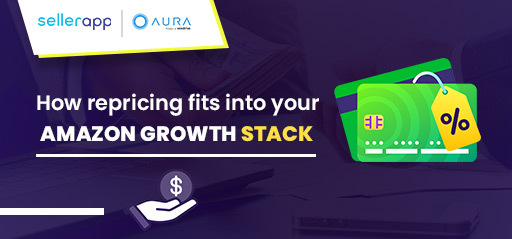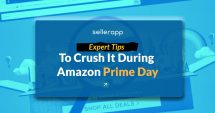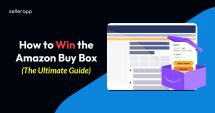How Repricing Fits into your Amazon Growth Stack

Many sellers are quick to figure out the basics of one of the selling models, such as Retail or Online Arbitrage, or selling Wholesale. Where many get stuck is scaling their operation.
In this guide, we’ll break down the systems mindset you should adopt, what a growth stack is, and how to apply repricing within that model to help you increase sales consistently month over month.
Adopting a Systems mindset
Two books fundamentally changed how I viewed my businesses. The E-Myth Revisited and Work The System by Sam Carpenter. While Work The System is more applicable in my opinion, they both teach a similar philosophy — your business is a collection of systems that can be tweaked to your desired results.
Want to increase your average net profit per unit? Tweak your sourcing and pricing systems.
Want to run the entire business from a laptop anywhere in the world? Tweak your physical systems like prepping.
By the end of the two books, you quickly realize that there are three major areas of systems in any Amazon business — Sourcing, Operations, and Sales.
Sourcing is pretty descriptive, but it’s the area where you decide where you purchase inventory from, how you decide if it’s profitable enough to purchase, and other important factors for your business.
Operations can be a bit trickier as it can include a variety of systems, such as how you prep your inventory, how you manage tracking your inbound and outbound inventory, when you decide to hire a new employee, or how you manage your taxes.
Sales, on the other hand, is pretty straightforward. It’s about maximizing your sales and profitability every single month.
Out of the three major areas, Sourcing and Sales have the most automation potential — using software and automated rules to manage these processes for you, sometimes entirely.
A bit of homework for you:
- Buy the two books mentioned above and take notes
- Write on a sheet of paper all of the systems you currently use in your business
- Brainstorm how each of these systems could be optimized or automated

Applying leverage where possible
Once you begin seeing your business as a collection of systems, you need to do something with this newfound knowledge. That’s where leverage comes into play.
Leverage is about making one plus one equal something greater than two. What’s important to understand about leverage is that it can be applied, almost, to no end. Where our time is a fixed resource, using leverage is not. This is where we transition from hours invested to outcomes generated as our measurement of success.
Here are a few sources of leverage that can be used:
- People — hiring can make a dramatic difference in reaching your goals
- Systems — build once, use it forever!
- Technology — begin using software, which we go deeper into later in the post
- Rule-based decision making — decide once, use endlessly to avoid decision fatigue
- Elimination — remove what is not necessary or adding value
- Learning — taking the time to learn how to be effective, or better use a tool, can save you a great deal of time
With your systems laid before you, you can begin to ask an important question — what form of leverage should I be applying to each system?
For example, you may struggle heavily with sourcing profitable inventory. Perhaps you need to focus on learning to do it better.
Alternatively, you may be fantastic at sourcing products, but you struggle with giving the task enough time. In this case, you’ll want to eliminate tasks to free up more time, begin using rules to speed up your decisions, and possibly hire someone who can source for you.
What you end up with is a map of what needs to be improved and a menu of options for improving each thing. No more stuck in limbo, wondering what you should be doing next or what’s holding you back from reaching your revenue goals this year.
Then, it’s all about executing on that map.
Setting up your growth stack
I’m going to take a nerdy word from the startup world for a moment and bring it to the Amazon world. A “stack” is simply a collection of things, which could be frameworks, systems, tools, rules, etc.
The supplement industry uses the term stack to describe a group of supplements that work well together.
The startup world uses the term stack to describe a collection of technology or tools — you can have a tech stack, a marketing stack, a customer support stack, etc.
For our purposes, I think it makes sense to use this term to think through your Amazon business. What’s your sourcing stack? Do you use tools like Tactical Arbitrage for sourcing your Online Arbitrage inventory?
What’s your operations stack? Do you create SOPs to document your different processes in a tool like Notion? Do you use a prep center to outsource all prep work? What’s the process for working with them?
What’s your sales stack? Do you ship inventory into FBA and forget about it or are you using a repricing tool like GoAura to ensure inventory sells for a competitive price and capital keeps flowing?
All of this can feel overwhelming at first, but pick one section—I would recommend sales—to start and then the next. Over a few months, your business should be humming along nicely. No more sleepless nights thinking about what’s potentially going wrong.
Where repricing tools fit in
One of the simplest things you can add to your growth stack is an advanced repricing tool like Aura. It allows you to use pre-configured repricing strategies to optimize your pricing across the board — optimal sales and profitability.
Additionally, you’re able to ensure that capital keeps flowing in your business, as we’ve seen far too many Amazon sellers have tens of thousands of dollars locked away in inventory. Instead, use the repricing system to ensure that’s never the case — freeing up more of your time to dive deeper in other areas like sourcing!
Recommended starting strategies
Getting started with repricing can feel overwhelming at first. It’s almost a sandbox of strategies you could begin playing around with. Rather than creating and testing every possible strategy imaginable, we want to create just two strategies that cover 80% of our inventory with ease.
Those two strategies are the Oscillation Strategy and the Liquidation Strategy.
The Oscillation Strategy is our go-to strategy while working with brand new, and even established, sellers. It takes advantage of how Amazon works — lowering your price to increase sales volume and raising your price to maintain a healthy average net profit.
What’s important with this strategy is getting past the idea that you’re “tanking the price.” This couldn’t be further from the truth. To increase sales volume, we need to be in the Buy Box. To be in the Buy Box we need a slightly better offer. The simple logic yields a lot of sales and profit.
Once we’ve reached a Minimum price, we then “reset” the price to a slightly higher one. This helps maintain a healthy average net profit per unit. The outcome is an increase in sales while maintaining a healthy net profit across the board. It’s really hard to beat!
Our second recommendation is less exciting for many sellers. Of course, I’m talking about the Liquidation Strategy. While none of us love the idea of losing money on inventory, it’s simply a part of doing business.
We make bad buying decisions from time to time and need to get our capital back. I cannot tell you how many sellers we see with tens of thousands of dollars locked in “stale” inventory.
A Liquidation Strategy works to get your capital back as quickly as possible, so you can quickly spend it again, but profitably. You also avoid paying long-term storage fees, which further eat away your profits.
Our general recommendation here is to decide on a maximum amount of time (generally three to four weeks) inventory given to sale before switching over to a Liquidation Strategy.
Final Thoughts
As you can tell, we geek out with the systems mindset. You’ll be hard-pressed to find a successful business owner who achieved what they have without using systems.
We urge you to complete the homework mentioned above to gain a ton of clarity on how your business is performing and where you can have the greatest impact on growth.
Additional Read:
Turbocharge Your Business with Amazon FBA Automation.
Benefits of having effective inbound and outbound logistics










Ashsloma
July 26, 2022Thanks for this nice post!
Arishekar N
August 12, 2022Glad you liked it.
Gabriel
July 26, 2022Informative article, just what I was looking for.
Arishekar N
August 12, 2022Thank you.
Bruce
July 26, 2022Your website is very useful. Thanks for sharing.
Arishekar N
August 12, 2022Thank you.